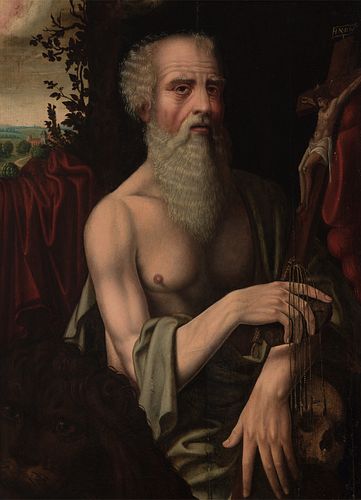Flemish school; XVI century. "Saint Jerome". Oil on panel.
Lot 92
About Seller
Setdart Auction House
Carrer Aragó 346
Barcelona
Spain
Setdart Subastas was born in 2004 and is currently the first online art auction in Spain with solidity, prestige and reliability guaranteed by our more than 60,000 users. Setdart has a young, dynamic and enterprising team ready to successfully manage the purchase and sale of art works through custom...Read more
Estimate:
EUR€15,000 - EUR€18,000
$16,129.03 - $19,354.84
Absentee vs Live bid
Two ways to bid:
- Leave a max absentee bid and the platform will bid on your behalf up to your maximum bid during the live auction.
- Bid live during the auction and your bids will be submitted real-time to the auctioneer.
Bid Increments
| Price | Bid Increment |
|---|---|
| EUR€0 | EUR€10 |
| EUR€200 | EUR€25 |
| EUR€500 | EUR€50 |
| EUR€1,000 | EUR€100 |
| EUR€3,000 | EUR€200 |
| EUR€5,000 | EUR€500 |
| EUR€10,000 | EUR€1,000 |
| EUR€20,000 | EUR€2,000 |
| EUR€50,000 | EUR€5,000 |
About Auction
By Setdart Auction House
Oct 20, 2021
Set Reminder
2021-10-20 07:30:00
2021-10-20 07:30:00
America/New_York
Bidsquare
Bidsquare : OLD MASTERS
https://www.bidsquare.com/auctions/setdart-auction-house/old-masters-7700
Setdart Auction House sofia@setdart.com
Setdart Auction House sofia@setdart.com
- Lot Description
Flemish school; XVI century. "Saint Jerome". Oil on panel. Requires cleaning and has restoration band on the back. Measures: 64 x 48 cm. In this work the artist reveals an exceptional sense of drawing through which he has described the anatomy of the saint, showing great precision. Especially achieved in the anatomical capture that is revealed through thin but defined muscles, which give a glimpse of the saint's life as a hermit. His anatomy presents a certain elongation of the forms, which makes the hands stand out in particular, rotund, but at the same time defined and refined. The face also reveals this technical care, which is determined by the treatment of the wrinkles and bags that can be seen under the saint's expressive eyes. The detail with which the hair has been painted stands out, and each hair that forms part of the beard can be seen. This shows the artist's interest in capturing an almost microscopic reality. This prominence of details and qualities is a characteristic feature of the Flemish school. This statement added to the hieratism and rotundity of the figure, invite us to think of aesthetic compositions close to the painter Ambrosius Benson (Region of Lombardy?, ca. 1490-1500 - Bruges, January 1550), whose Saint Jerome in the collection of the Mayer van den Bergh Museum in Antwerp, has great similarities with this work. In both pieces the saint is immersed in a rocky interior, which opens slightly to the landscape in the upper left area. Located in the center of the composition, St. Jerome, dressed in a grayish tunic that reveals his torso, holds a cross with the body of Christ in his hands. It is at this point where the two works differ since, in the painting of the museum, the saint only holds the cross. Finally, the work is completed with the iconographic attributes typical of St. Jerome, such as the lion and the skull. Ambrosius Benson was one of the so-called masters of the tradition, successor of Van der Goes, and showed the influence of Van Eyck, Van der Weyden and the Flemish primitives in general. However, in his work we can appreciate features already typical of the 16th century, coming from Italy, such as the triangular composition that we see in this work. Originally from Lombardy, more Italian features can be appreciated in his painting. As we can see in this workshop work, especially important was his personal use of color, with a predominance of maroon tones in contrast to the whites and light tones of the flesh tones, which are thus very highlighted in the composition. Also typical of his work is the velvety quality of the cloaks. Benson was a painter of religious subjects and portraits, and trained with Gerard David in Bruges from 1518, the year he became a citizen there. The representation of St. Jerome has been one of the most represented subjects in the art world. Whether as a penitent or as a sage, the saint's biography has served to connect with the faithful and transmit the values of the Church. Saint Jerome was born near Aquileia (Italy) in 347. Trained in Rome, he was an accomplished rhetorician, as well as a polyglot. Baptized at the age of nineteen, between 375 and 378 he retired to the Syrian desert to lead an anchorite's life. He returned to Rome in 382 and became a collaborator of Pope Damasus. The accumulation of books and parchments next to the saint alludes to the saint's translation of the Bible into Latin, which was considered the only official translation since the Council of Trent. The theme of St. Jerome hearing the trumpet of the Last Judgment would become fashionable in Counter-Reformation Europe, and would gradually impose itself, displacing the previous interpretations of the saint as a sage or as a penitent.
- Shipping Info
-
In-house shipping available. Please inquire at admin@setdart.com.
-
- Buyer's Premium



 EUR
EUR CAD
CAD AUD
AUD GBP
GBP MXN
MXN HKD
HKD CNY
CNY MYR
MYR SEK
SEK SGD
SGD CHF
CHF THB
THB










